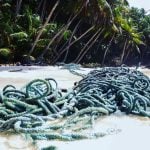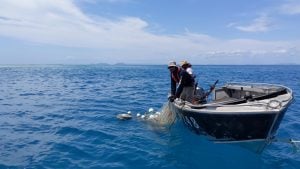Project ReCon SRP
Source Reduction Plan (SRP) Overview
Name of SRP
Partners Delivering the SRP
- Tangaroa Blue Foundation
- Satlink – a world-leading provider of technological solutions for the fishing sector.
- Ocean Conservancy
- Global Ghost Gear Initiative
- Carpentaria Contracting
Location
Northern Australian Oceans & The Great Barrier Reef
Photo 1
Evidence of the issue

Photo 2
Evidence of SRP resources
Photo 3
Evidence of positive outcomes
Overall Goals & Background
Targeted Debris
Ghost Nets and Ghost Gear
Why is the SRP needed?
Ghost nets are considered one of the most damaging types of plastic marine debris, with an estimated 2% of fishing gear lost annually, which can drift in the ocean from days to years. This poses a huge problem in the world’s oceans including Australia’s northern oceans and the Great Barrier Reef, where sadly we see tonnes of fish, dugongs, turtles and other marine species getting tangled up, and coral reefs are put at risk.
With lost or discarded ghost nets the size of football fields currently drifting unsupervised across the Great Barrier Reef, they are causing untold damage to marine life and fragile corals as they become entangled on reefs. Sometimes a ghost net can’t be removed due to its size and the capacity of the vessel and crew who find them, unfortunately drifting away from their reported locations. Project ReCon gives the ability for those who find ghost gear, to tag it so we can arrange for its removal with the appropriate equipment and expertise.
In a world-first, Tangaroa Blue Foundation, Satlink and AMDI partners have designed a program that uses retrieved and repurposed satellite technology to track and remove deadly and destructive ghost nets.
Previously, vessels could report a ghost net to authorities for removal but it may drift away by the time a removal team could be mobilised. With Project RecCon, a buoy can be immediately attached and the net’s movement tracked in real-time by satellites until a retrieval team is mobilised. Project ReCon will allow international commercial fishing fleets to donate any of their buoys found during beach clean-ups to be reassigned to Tangaroa Blue Foundation and used with AMDI partners to track these nets.
Implementing Project ReCon across Northern Australia will help reduce technological waste, reduce impacts on coastal environments and benefit the local Australian communities that find the “echo-sounder” buoy.
We can also re-purpose these echosounders into virtual fences that can be established and utilised to notify relevant agencies when a tracked ghost net is in proximity to sensitive marine environments (reefs) or poses a navigational hazard to ships. This proactive approach enhances the protection of our precious ocean ecosystems.
Logistics
Timeline and Project Goals
2022 – present (project is ongoing)
Tangaroa Blue Foundation has been finding these commercial fishing echo-sounder buoys for many years during clean-ups, along with thousands of kilometres of ghost nets. All of these have been recorded in the Australian Marine Debris Initiative (AMDI) Database. This new ongoing project will allow us to use previous (and new) echo-sounder buoys found on beach cleans.
Measuring Success
As part of the program, Tangaroa Blue Foundation’s AMDI partners (which include Indigenous Rangers, tourism operators and commercial vessels) will deploy the buoys as part of their operational work.
To enable the deployment, Tangaroa Blue Foundation provides training on how to report findings, assessments, testing, and implementation of the buoys.
Up until January 2024, there have been 20 Project ReCon buoys distributed to partners across northern Australia.
3 buoys have been deployed on ghost gear with 100% retrieval success.
Training has been provided to all of the 20 AMDI partners who are hosting the Project ReCon buoys.
Data Collection & Reporting
- Number of trackers recovered during clean-ups.
- Number of trackers that could be repurposed for Project ReCon
- Number of deployments of the trackers
- Number of retrievals of deployed trackers and ghost gear
- Ghost gear recorded in the AMDI Database.
Results and Reflections
Positive Outcomes
So far (until Jan 2024) 3 buoys have been deployed on ghost gear with 100% retrieval success.
Project ReCon and Tangaroa Blue featured on a 4-page spread in SatLink’s 2023 Sustainability Report. SatLink have continued to be a bridge between Tangaroa Blue and industry partners, whose co-operation is integral to the success of the project.
Funding
Overall Costs:
Tangaroa Blue Foundation’s ReefClean project is funded by the Australian Government’s Reef Trust.
The initial investment from ReefClean was $10,000
The Global Ghost Gear Initiative funded 12 months of the program through a $40,000 US grant which helped recover, test and redistribute trackers that were found on beach clean-ups or donated by third partners. This funding also facilitated the creation of training resources, running training sessions, and helping to recover the ghost gear (in addition to supporting analysis of the tracked data to help assess ocean modelling).
Challenges & Improvements
Many fishing vessels use these echo-sounder buoys – the biggest challenge was having their approval for the buoys found during beach clean-ups to be resigned to Tangaroa Blue Foundation. Satlink’s relationships with the commercial fishing fleets enabled this to happen.
Damaged buoys or buoys deemed unusable during the assessment will aim to be recycled. Tangaroa Blue is working with Satlink to identify fit-for-purpose recycling opportunities for buoys that can’t be included in Project ReCon.
Future Opportunities
By working with international commercial fishing fleet partners we can have the buoys recovered by Tangaroa Blue and their AMDI partners tested and reassigned to track ghost nets along the Reef.
“The technology also allows for virtual fences to be put around reefs providing notifications before nets impact critically sensitive areas” – Kathryn Gavira, Satlink’s Head of Science & Sustainability.
The project has been welcomed by the Special Envoy for the Great Barrier Reef and Labor Senator for Queensland, Senator Green: “This exciting new project by the Tangaroa Blue Foundation is a further step in the right direction to one day ensuring our waters are free from ghost nets. Well done to everyone involved.”






